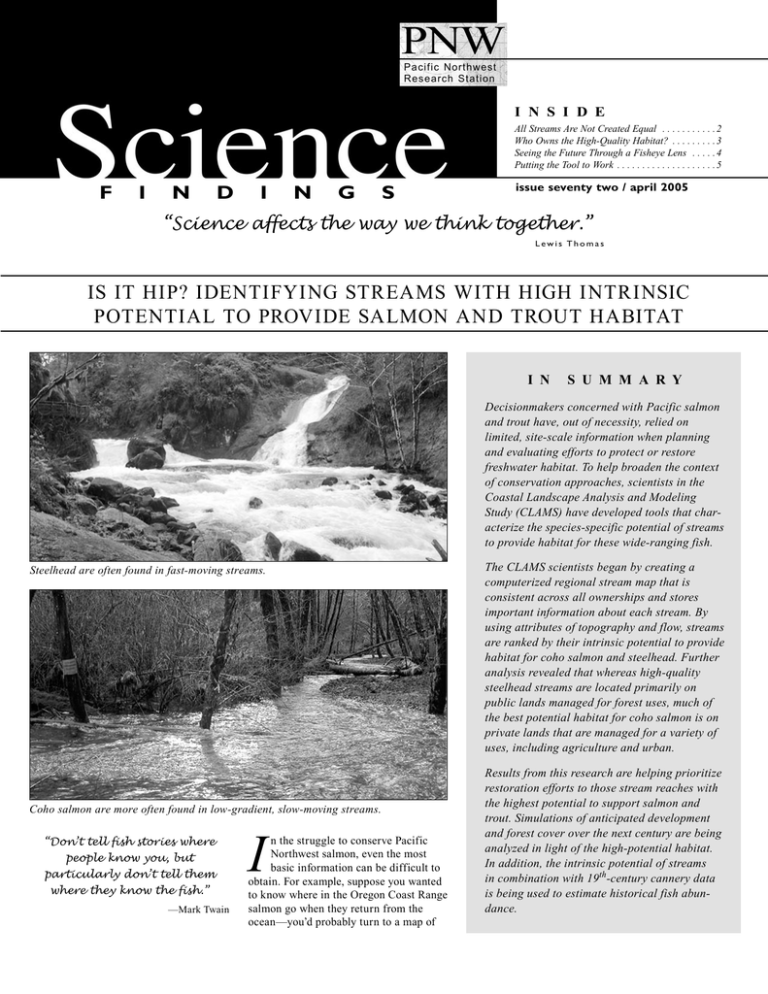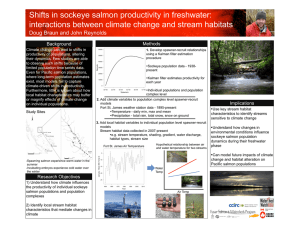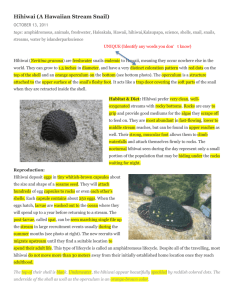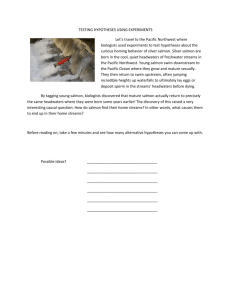PNW
advertisement

PNW Pacific Northwest Research Station I N S I D E All Streams Are Not Created Equal . . . . . . . . . . . 2 Who Owns the High-Quality Habitat? . . . . . . . . . 3 Seeing the Future Through a Fisheye Lens . . . . . 4 Putting the Tool to Work . . . . . . . . . . . . . . . . . . . . 5 F I N D I N G S issue seventy two / april 2005 “Science affects the way we think together.” Lewis Thomas IS IT HIP? IDENTIFYING STREAMS WITH HIGH INTRINSIC POTENTIAL TO PROVIDE SALMON AND TROUT HABITAT I N S U M M A R Y Decisionmakers concerned with Pacific salmon and trout have, out of necessity, relied on limited, site-scale information when planning and evaluating efforts to protect or restore freshwater habitat. To help broaden the context of conservation approaches, scientists in the Coastal Landscape Analysis and Modeling Study (CLAMS) have developed tools that characterize the species-specific potential of streams to provide habitat for these wide-ranging fish. Steelhead are often found in fast-moving streams. Coho salmon are more often found in low-gradient, slow-moving streams. “Don’t tell fish stories where people know you, but particularly don’t tell them where they know the fish.” —Mark Twain I n the struggle to conserve Pacific Northwest salmon, even the most basic information can be difficult to obtain. For example, suppose you wanted to know where in the Oregon Coast Range salmon go when they return from the ocean—you’d probably turn to a map of The CLAMS scientists began by creating a computerized regional stream map that is consistent across all ownerships and stores important information about each stream. By using attributes of topography and flow, streams are ranked by their intrinsic potential to provide habitat for coho salmon and steelhead. Further analysis revealed that whereas high-quality steelhead streams are located primarily on public lands managed for forest uses, much of the best potential habitat for coho salmon is on private lands that are managed for a variety of uses, including agriculture and urban. Results from this research are helping prioritize restoration efforts to those stream reaches with the highest potential to support salmon and trout. Simulations of anticipated development and forest cover over the next century are being analyzed in light of the high-potential habitat. In addition, the intrinsic potential of streams in combination with 19th-century cannery data is being used to estimate historical fish abundance. the stream network. Not so fast, says Kelly Burnett. “None of the widely available maps accurately represent all of the streams in this area.” “The Coast Range has incredibly high stream densities. Abundant rainfall and steep, dissected slopes can produce densities up to 12 miles of stream for every 1 square mile of forest,” explains Burnett. These high stream densities are why the commonly available maps for the Coast Range are inadequate for many uses — they include only a fraction of the streams that are actually in the landscape. However, where terrain is flatter and rainfall is less, such as many areas east of the Cascades, available stream maps may be perfectly adequate. To remedy the problem for the Coast Range, the Bureau of Land Management and Forest Service added streams to maps that cover the lands they manage. When maps for federal and private lands are stitched together, just a glance reveals a major problem. The web of blue lines that indicate stream locations on public lands is complex and dense. On private lands, in contrast, that network of blue is comparatively sparse—only the major streams are shown. Of course, the world is not as the map would have you believe; streams do not dry up when they transition to private land. Rather, there has simply been less investment in mapping streams on private lands. When Burnett, a fish biologist at the Pacific Northwest Research Station in Corvallis, Oregon, set out to find the best potential habitat for salmon in the Coast Range, she was confronted with this map and all its shortcomings. “We had no way to consistently evaluate habitat potential across the province,” she says. “We had to start from scratch. We built an entirely new stream layer.” There are very high stream densities in the Oregon Coast Range. Until recently, only streams on public lands were adequately mapped. The new map was based on a simple idea: water flows downhill. With support from federal agencies and the Oregon Watershed Enhancement Board, Burnett and her colleagues spearheaded development of a detailed elevation map, called a digital elevation model. This is a computerized grid that contains millions of cells—each one represents a 10-meter square on the ground and contains the elevation for that location. Once this was done, they created a computer model that could follow the path in which rainwater flows after it hits the ground. This maps where a stream starts based on topography and then traces its route downstream. A L L ST R E A M S A R E NOT C R E AT E D E QUA L A ny angler can tell you that all fish are not in all places at all times—that would make life too easy. Rather, each fish species has specific habitat requirements; their body morphology, their diet, and their reproductive strategies are all adapted to certain conditions. For example, if you want to find coho salmon you should look in low gradient, slow-moving streams; this is their freshwater niche. In contrast, if you’re looking for steelhead, higher gradient, fastmoving streams are what you’re after. “Coho and steelhead are known to have contrasting habitat requirements. That’s why we chose them when it came time to map habitat potential in the Coast Range. We knew that some stream reaches would have high Once Burnett was armed with a reliable map of the stream network, she returned to her primary research questions: Which streams have the highest potential for providing salmon and trout habitat? Who owns the land adjacent to these streams? And, how are they being managed? Purpose of PNW Science Findings To provide scientific information to people who make and influence decisions about managing land. PNW Science Findings is published monthly by: Pacific Northwest Research Station USDA Forest Service P.O. Box 3890 Portland, Oregon 97208 (503) 808-2137 Send new subscriptions and change of address information to pnw_pnwpubs@fs.fed.us Sherri Richardson Dodge, editor srichardsondodge@fs.fed.us Keith Routman, layout kroutman@fs.fed.us Science Findings is online at: http://www.fs.fed.us/pnw The site includes Science Update—scientific knowledge for pressing decisions about controversial natural resource and environmental issues. United States Department of Agriculture Forest Service 2 potential for coho and other reaches would have high potential for steelhead,” explains Burnett. Burnett’s method of gauging potential habitat quality focuses on the portion of a fish’s life history spent bulking up in freshwater. This is considered an important stage with regard to the influence of land management in maintaining healthy populations. However, these fish need to spawn and travel to and from the Pacific Ocean; therefore, the quality of habitats used for other life stages is important too. By evaluating attributes of topography and streamflow, which are produced along with the new stream map, Burnett was able to quantify and map the “intrinsic potential” for every Coast Range stream. Intrinsic potential is a measure of a stream’s capacity to provide high-quality habitat for coho and steelhead. As expected, the map shows few streams that have high intrinsic potential for both species. Although the map says nothing about the current status of fish populations or actual habitat conditions, it is an excellent prioritization tool and can increase the efficiency of fish conservation efforts. According to Burnett, areas with high intrinsic potential may be good candidates for protection when they have been unaffected by past management and for restoration when management impacts have been greater. Conversely, areas with low habitat potential may be good places to locate more intensive management. K EY FI N DI NGS • A method was developed that quickly and accurately represents the location, spatial extent, and attributes of streams over broad areas from widely available digital elevation data. The resulting high-resolution map of the stream network remedies many deficiencies found in existing stream maps. • The intrinsic potential to provide steelhead and coho salmon habitat was calculated and then mapped for all Oregon Coast Range streams. Stream attributes associated with freshwater habitat use differ for coho salmon and steelhead. Therefore, stream reaches with high intrinsic potential generally do not overlap for these two species. • Stream reaches in the Oregon Coast Range with high intrinsic potential for steelhead tend to differ from those for coho salmon regarding land ownership, land use, and streamside vegetation. High-intrinsic-potential reaches for steelhead occur typically on publicly owned forest lands, whereas high-intrinsic-potential reaches for coho salmon occur commonly on privately owned lands with various uses. Maps of intrinsic potential have offered a new perspective for salmon and trout conservation. “Decisionmakers have, out of necessity, relied on limited site-level information when planning to protect or restore freshwater habitat,” says Burnett. “They now have a tool to broaden the context for considering conservation approaches.” have high intrinsic potential for something, even if it’s not fish. “Hopefully, the method we’ve developed can help focus conservation efforts—whatever the species—by identifying locations that will yield the greatest benefit,” she says. “This study focused on steelhead and coho, but the tools may be adapted to any freshwater species whose distributions are influenced by topography or streamflow,” says Burnett. And it’s likely that all streams W HO OW NS T H E H IGH - QUA L I T Y H A BI TAT ? O nce Burnett knew where the streams with the highest intrinsic potential were, she then set out to evaluate what might be influencing them. This meant finding out who owns the land adjacent to the streams and how this land is being managed. Using geographic databases for the Coast Range compiled by the Coastal Landscape Analysis and Modeling Study (CLAMS), Burnett summarized categories of land ownership, land use, and forest cover in riparian areas of the high-intrinsic-potential streams. The analysis showed that the best streams for a species were not distributed evenly across ownerships. “High-intrinsic-potential stream reaches for steelhead occur predominately on publicly owned forest lands, while high-intrinsicpotential reaches for coho salmon occur commonly on privately owned lands with various uses,” explains Burnett. “As a result, these reaches tend to differ also in streamside vegetation.” Within a given watershed, there is not much overlap between the streams with high intrinsic potential for coho salmon and those with high potential for steelhead. 3 Compared to coho salmon habitat, there is a high proportion of high-quality steelhead habitat in a forested condition, now and into the future. As it turns out, private landowners and coho salmon have something in common; they both like wide valleys. Historically, the larger and broader river valleys were settled first because they more readily accommodated homes, farms and roads. In contrast, steep slopes were rarely developed and often ended up in the public land system. Now, the history of land tenure and continued development of valley bottoms is affecting salmon conservation. “Although everyone expects to find prime coho habitat in the valleys, it was eye-opening to quantify such an extreme difference between coho and steelhead in how the best habitat potential is distributed among land ownerships,” says Burnett. Streams adjacent to private lands—such as many of those with the best potential coho habitat—are more likely to be impacted by agricultural runoff and consequences of urban development. In fact, “streams with high potential habitat for coho salmon are almost twice as likely to be managed for uses other than forestry than are those for steelhead,” says Burnett. This may help explain why coho populations in coastal Oregon streams have been in trouble for years and were listed under the Federal Endangered Species Act in 1998. “Widespread recovery for coho salmon is uncertain unless habitat can be protected or improved in high-intrinsic-potential stream reaches on private lands,” says Burnett. Steelhead have comparably healthy populations in the Coast Range. The riparian areas of streams with high intrinsic potential are most often managed for forest uses and frequently contain large trees. Good news for steelhead—and an important responsibility for both private and public timberland managers. SE EI NG T H E F U T U R E T H ROUGH A F ISH E Y E L E NS A valuable feature of Burnett’s method is its relative insensitivity to time. Because a stream’s potential to provide habitat is based only on topographic attributes, a stream with high intrinsic potential for coho salmon had exactly the same potential a century ago as it will have a century hence. To be clear, many things affect a stream’s actual habitat condition—such as landslides, dams, and development—but the potential habitat remains unchanged. Therefore, mapping the intrinsic potential of streams is helping scientists examine the past and project the future. Burnett, along with other CLAMS scientists, used computerized simulations to forecast conditions near high-intrinsic-potential streams over the next century under current policies. Their methods incorporate estimates of human population expansion, projections for continued logging, and the natural cycle of growth and death in the forests. Land managers can use the mapped intrinsic potential to prioritize management and conservation across broad areas. 4 As you might expect, development of homes and roads are projected to increase in the valleys, disproportionately affecting the streams with high intrinsic potential for coho salmon. Forests on public land, in contrast, are expected to continue to grow, increasing the amount of large trees in and adjacent to streams, thereby improving steelhead habitat. “As far as steelhead are concerned, we have good conservation options now and into the future. Our options for coho salmon may be more limited but more urgent to implement before lands adjacent to high-intrinsic-potential reaches are further developed,” says Burnett. L A N D M A N AG E M E N T I M P L I C A T I O N S • An accurate representation of the stream network is a foundation for delineating streamside buffers as well as characterizing mean annual streamflow and likelihood of fish presence, which are commonly used to determine which riparian rules are applicable. Such information, when available across large areas, can help managers plan more efficiently. • Targeting activities to the intrinsic potential of a reach or watershed helps landowners efficiently achieve both conservation and commodity production objectives. Areas with high intrinsic potential may be good candidates for habitat protection. Conversely, areas with low intrinsic potential may be good candidates for intensive management. • Intrinsic potential maps have enabled historical coho salmon abundance to be estimated for Oregon Coast Range streams that lack cannery records. These historical abundances are being used to compare with current abundances and to identify independent populations in meeting Endangered Species Act requirements. PU T T I NG T H E TO OL TO WOR K O ver just a few years, Burnett and her colleagues have changed the circumstances in which fish managers in the Oregon Coast Range operate. They have created tools that allow a holistic assessment of a resource that means so much to Oregonians. “The stream map alone has applications well beyond our research,” says Burnett. And by using these together with the intrinsic potential maps, land management and regulatory agencies can make great new strides. Consider, for example, the number of times a road crosses a stream in the Coast Range. Each of these intersections requires a culvert. Old and poorly maintained culverts block fish access and sever upstream habitat from the rest of the stream network. Thanks to Burnett’s research, the Oregon Department of Forestry and the Siuslaw National Forest can now overlay maps of intrinsic potential onto their road-culvert maps to assess the number of miles of high-potential habitat for steelhead and coho made available by each culvert repair. A great way to optimize restoration dollars. “The Oregon and Northern California Technical Recovery Team for coastal coho salmon is estimating the historical abundance of this species from maps of intrinsic potential. River-specific estimates of the number of returning coho salmon taken from historical cannery records are highly correlated with estimates from the intrinsic potential maps,” explains Burnett. The historical cannery records are available for only a very few streams. The relationship between cannery records and intrinsic potential is helping fill the gaps, enabling historical coho salmon abundance to be estimated for Coast Range streams that lack cannery records. The historical abundances are being applied to help meet Endangered Species Act requirements. The state of Oregon is using maps of intrinsic potential to evaluate past conservation actions for coastal coho salmon undertaken through the Oregon Plan for Salmon and Watersheds. “Restoration and protection are likely to be most effective for long-term recovery of fish populations when located in areas with a capacity to produce high-quality habitat,” says Burnett. Over the next few years Burnett’s team will conduct further evaluations with fish data, develop new models that seek out high-quality habitat for other species, and take their existing methods into new regions of the Pacific Northwest. Burnett and her team began by asking: Where are the streams with the highest intrinsic potential to support salmon and trout? But they were temporarily rebuffed while first having to answer: Where are the streams? They have shown that sometimes, to get at the complex questions you must first address the fundamentals. “If you want to make an apple pie from scratch, you must first create the universe.” —Carl Sagan FOR F U RT H E R R E A DI NG Burnett, K.; Reeves, G; Miller, D; Clarke, S.; Christiansen, K; Vance-Borland, K. 2003. A first step toward broad-scale identification of freshwater protected areas for Pacific salmon and trout in Oregon, USA. In: Beumer, J.P.; Grant, A; Smith, D.C., eds. Aquatic protected areas: What works best and how do we know? Proceedings of the world congress on aquatic protected areas, Cairns, Australia, North Beach, WA, Australia: Australian Society for Fish Biology. Burnett, K.; Miller, D.; Reeves, G.; Spies, T.; Clarke, S.; Vance-Borland, K.; Christiansen, K. Distribution of salmon habitat potential in the coastal province of Oregon. Manuscript in preparation. W R I T E R ’ S P R O F I L E Jonathan Thompson is a science writer and ecologist. He lives in Corvallis, Oregon. 5 F I N D I N G PRSRT STD US POSTAGE PAID PORTLAND OR PERMIT N0 G-40 S U.S. Department of Agriculture Pacific Northwest Research Station 333 SW First Avenue P.O. Box 3890 Portland, OR 97208-3890 Official Business Penalty for Private Use, $300 SCIENTIST PROFILE KELLY BURNETT is a research fish biologist and has been with the PNW Research Station since 1988. She received her B.S. degrees in biology and chemistry from Berry College and her M.S. and Ph.D. degrees in fisheries science from Oregon State University. Her current research focuses on classifying streams and watersheds, modeling effects of disturbance on salmon and their habitats, and studying relationships between land management and stream ecosystems. Burnett can be reached at: Pacific Northwest Research Station/USDA Forest Service Forestry Sciences Laboratory 3200 SW Jefferson Way Corvallis, OR 97331 Phone: (541) 750-7328 E-mail: kmburnett@fs.fed.us COLLABOR ATORS Dan Miller, Earth Systems Institute, Seattle, Washington Gordon Reeves, PNW Research Station, Corvallis, Oregon Sharon Clark, Roaring Fork Conservancy, Basalt, Colorado Ken Vance-Borland, Oregon State University Tom Spies, PNW Research Station, Corvallis, Oregon K. Norman Johnson, Oregon State University Jeff Kline, PNW Research Station, Corvallis, Oregon Janet Ohmann, PNW Research Station, Corvallis, Oregon Kelly Christiansen, PNW Research Station, Corvallis, Oregon The U.S. Department of Agriculture (USDA) prohibits discrimination in all its programs and activities on the basis of race, color, national origin, gender, religion, age, disability, political beliefs, sexual orientation, or marital or family status. (Not all prohibited bases apply to all programs.) Persons with disabilities who require alternative means for communication of program information (Braille, large print, audiotape, etc.) should contact USDA’s TARGET Center at (202) 720-2600 (voice and TDD). To file a complaint of discrimination, write USDA, Director, Office of Civil Rights, Room 326-W, Whitten Building, 14th and Independence Avenue, SW, Washington, DC 20250-9410 or call (202) 720-5964 (voice and TDD). USDA is an equal opportunity provider and employer. USDA is committed to making its information materials accessible to all USDA customers and employees.






